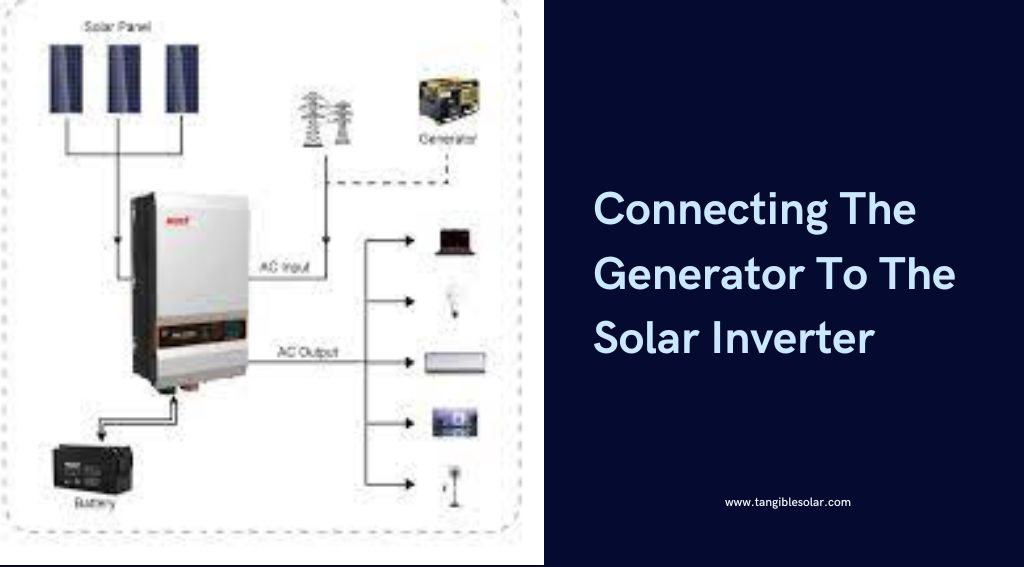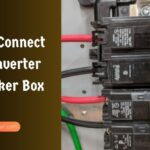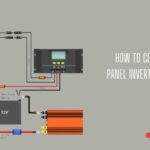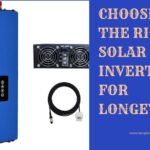How to Connect Generator to Solar Inverter: Complete Guide
To connect a generator to a solar inverter, you need to follow a specific wiring process and use a transfer switch to switch between power sources smoothly. This allows the solar inverter to automatically charge the battery bank with solar power and switch to generator power when needed.
Connecting a generator to a solar inverter is a crucial step in ensuring a backup power supply during utility outages or when solar energy is insufficient. By seamlessly integrating the generator with the solar power system, you can maximize the utilization of renewable energy while keeping your home or business running smoothly.
We will guide you through the process of connecting a generator to a solar inverter, highlighting the necessary steps and important components required for a successful setup. By understanding and implementing the proper wiring procedures, you can effectively harness the power of both solar energy and generators to meet your electricity needs.
Understanding The Connection Process
Connecting a generator to a solar inverter is a smart and efficient way to ensure a continuous power supply for your home or business. By combining the strengths of these two power sources, you can enjoy the benefits of renewable energy while still having a backup option during periods of low solar output or power outages.
Differentiating Between A Generator And A Solar Inverter
To understand the connection process, it’s important to differentiate between a generator and a solar inverter. Both have their own unique functions, but combined, they create a reliable and versatile power system.
| Generator | Solar Inverter |
| A generator is a device that converts mechanical energy into electrical energy. It typically runs on fossil fuels such as gasoline, diesel, or propane. | A solar inverter, on the other hand, is an essential component of a solar power system. It transforms the direct current (DC) electricity that solar panels produce into alternating current (AC) electricity that can power your home or place of business. |
| Generators are commonly used as backup power sources or in situations where grid power is unavailable. | Solar inverters enable you to harness the energy of the sun, reducing your dependence on traditional energy sources and helping to lower your carbon footprint. |
Highlighting The Benefits Of Connecting A Generator To A Solar Inverter
Connecting a generator to a solar inverter offers a range of benefits, making it a practical and cost-effective choice for many users.
- 1. Continuous power supply: By combining a generator with a solar inverter, you can ensure a continuous power supply even during periods of low solar output or power outages. This reliability is especially crucial for businesses that need to maintain operations or households that rely on medical equipment.
- 2. Cost savings: Solar energy is a renewable source of power, and by harnessing the sun’s energy, you can reduce your reliance on grid electricity and lower your utility bills. Additionally, using a generator as a backup power source can help you avoid costly downtime or spoilage of perishable goods during power outages.
- 3. Environmental benefits: Solar energy is clean and green, producing no harmful emissions or pollutants. By connecting a generator to a solar inverter, you can reduce your carbon footprint and contribute to a sustainable future.
- 4. Versatility: The combination of a generator and a solar inverter provides you with a flexible and versatile power system. You can choose to use solar power during the day and rely on the generator at night or during inclement weather. This versatility ensures that you have power whenever you need it, regardless of the circumstances.
Now that you have a clearer understanding of the connection process, you can explore the specific steps required to connect a generator to a solar inverter. Stay tuned for our upcoming blog post on the step-by-step guide.
Preparing For The Connection
Assessing the Power Requirements Of The Connected Load
Before connecting your generator to a solar inverter, it’s crucial to assess the power requirements of the connected load. This step ensures that your generator is capable of supplying sufficient power to meet the needs of your electrical appliances and devices.
Here are a few steps you can follow to assess the power requirements:
- Make a list of all the electrical appliances and devices you wish to power with your generator.
- Refer to the manufacturer’s specifications or appliance labels to find the power consumption in watts for each item on your list.
- Add up the power consumption of all the appliances and devices to determine the total power requirements.
By assessing the power requirements of the connected load, you can ensure that the generator you choose is capable of meeting your electricity needs effectively.
The Right Generator For Your Solar Inverter System
Once you’ve assessed the power requirements of the connected load, it’s time to select the right generator for your solar inverter system. Here are a few factors to consider:
- Power Output: Ensure that the generator you choose can provide the required power output to meet the total power requirements of your connected load.
- Fuel Type: Consider the availability and cost of the fuel required to run the generator. Options include gasoline, diesel, propane, or natural gas.
- Noise Level: If noise is a concern, opt for a generator that operates quietly, especially if you plan to use it in a residential area.
- Portability: Determine if you need a portable generator that can be easily moved around or a stationary one for a fixed installation.
By considering these factors, you can choose a generator that not only meets your power requirements but also aligns with your specific needs and preferences.
Proper Grounding And Safety Measures
Prioritizing grounding and safety measures is essential to prevent electrical hazards and ensure the smooth and reliable operation of your generator and solar inverter system. Here are some key steps to follow:
- Proper Grounding: Ensure that your generator and solar inverter system are properly grounded according to local electrical codes and guidelines. This helps reduce the risk of electrical shock or fire in the event of a fault.
- Safe Connections: Use correct and secure connectors, cables, and wiring to connect the generator to the solar inverter. Follow the manufacturer’s instructions and guidelines to prevent loose connections or short circuits.
- Monitoring and Maintenance: Regularly inspect and maintain your generator, solar inverter, and associated equipment to detect and rectify any potential issues that could compromise safety.
By adhering to proper grounding and safety measures, you can operate your generator and solar inverter system with peace of mind, ensuring the safety of both your electrical system and the people using it.
Connecting The Generator To The Solar Inverter

Step-by-step Guide On Connecting The Generator To The Solar Inverter
Connecting a generator to a solar inverter is a smart way to ensure an uninterrupted power supply, even during extended periods of cloudy weather or when the solar panels don’t produce enough electricity. By harnessing the complementary strengths of both the generator and the solar inverter, you can safeguard your power needs and have peace of mind.
Follow this step-by-step guide to seamlessly connect your generator to the solar inverter:
Checking the compatibility between the generator and the inverter
Before proceeding, it is essential to ensure that your generator and solar inverter are compatible. Check the specifications and guidelines provided by the manufacturers to verify compatibility. Consider factors such as wattage, voltage, and frequency requirements to prevent any potential damage to the devices.
Establishing the necessary electrical connections
Once compatibility is confirmed, you can begin establishing the electrical connections. Start by turning off all power sources and disconnecting the solar panels from the inverter. Connect the generator to the inverter using appropriate cables or wires, ensuring a secure and tight connection.
Configuring the transfer switch for seamless switching between power sources
In order to facilitate smooth switching between the generator and solar power, a transfer switch must be installed. The transfer switch allows for automatic switching between the power sources based on availability. This ensures a reliable and uninterrupted power supply without the need for manual intervention.
Conducting a thorough testing and troubleshooting process
After establishing the connections and configuring the transfer switch, it is crucial to conduct a comprehensive testing and troubleshooting process. Test the setup by turning on the generator and ensuring the power seamlessly switches to it in the absence of solar power. Similarly, test the transition back to solar power when it becomes available.
By following this step-by-step guide, you can connect your generator to the solar inverter and enjoy the benefits of a reliable power source that combines the efficiency of solar energy with the backup capabilities of a generator. Be sure to consult the user manuals provided by the manufacturers for detailed instructions specific to your generator and solar inverter models.
Maintaining And Troubleshooting
Regular maintenance and troubleshooting are crucial for ensuring a reliable connection between a generator and a solar inverter. By following these maintenance tips and knowing how to address common issues, you can keep your power system running smoothly.
Regular Maintenance Tips To Ensure The Reliability Of The Connection
Regular maintenance plays a significant role in extending the lifespan of your generator and solar inverter connections. Here are some essential maintenance tips:
- Inspect and clean the cables and connections regularly to prevent corrosion and ensure proper conductivity.
- Keep the generator and solar inverter clean and free from dust and debris, as these can affect their performance.
- Check the fuel and oil levels in the generator regularly and refill as needed.
- Inspect and clean the air filters in both the generator and solar inverter to promote efficient airflow and prevent overheating.
- Regularly test the batteries in the solar inverter and replace them if necessary to maintain optimal power storage.
Troubleshooting Common Issues That May Arise In The Connection Process
Even with regular maintenance, you may encounter some issues when connecting a generator to a solar inverter. Here are some common problems and their solutions:
- Generator startup failures: If your generator fails to start, check the fuel levels and ensure the generator is properly connected to the solar inverter. You may also want to inspect the spark plug and fuel filter for any issues.
- Issues with the transfer switch: If you experience problems with the transfer switch, such as failure to switch between generator and solar power, check the wiring connections and ensure they are secure. Consider replacing the transfer switch if it is faulty.
- Power fluctuations and load management concerns: Power fluctuations can occur due to imbalanced loads or high-demand appliances. Ensure that the load is evenly distributed across circuits and avoid overloading the generator or solar inverter. Consider implementing a load management system to optimize power usage.
Addressing Issues With The Transfer Switch
The transfer switch is a critical component in the generator-to-solar-inverter connection process. If you encounter issues with the transfer switch, here are some steps you can take:
- Inspect the transfer switch for any loose connections and tighten them if necessary.
- Check the fuses or circuit breakers associated with the transfer switch and replace them if they are faulty.
- If the transfer switch is not functioning properly, consider consulting a professional electrician to diagnose and repair the issue.
By addressing transfer switch issues promptly, you can maintain a seamless transition between the generator and solar power sources.
Dealing With Power Fluctuations And Load Management Concerns
Stability in power output is essential for a reliable connection between the generator and solar inverter. Here are some ways to address power fluctuations and manage the load:
- Ensure that the load is evenly distributed across circuits to prevent overloading.
- Consider implementing a load management system that automatically switches off non-essential appliances during peak load times.
- Regularly monitor and assess your power usage to identify potential areas for load reduction or optimization.
By implementing effective load management strategies, you can ensure a stable power supply and maximize the efficiency of your generator-to-solar-inverter connection.
Frequently Asked Questions For How To Connect Generator To Solar Inverter
Can a solar inverter be connected to a generator?
Yes, a solar inverter can be connected to a generator to provide backup power. The solar inverter can convert the DC power from the generator into AC power that can be used to run household appliances. However, it is important to ensure compatibility and proper installation for efficient operation.
Can I connect my generator to my solar system?
Yes, you can connect your generator to your solar system. They can work together to provide backup power when needed. Ensure that the generator is compatible with your solar system, and consult a professional for proper installation.
How Do You Sync a Generator to a Solar System?
To sync a generator with a solar system, you need to connect it through a transfer switch or an inverter with generator input. The switch or inverter ensures a seamless transition between the solar panels and the generator, allowing them to work together without any complications.
Can You Run a Generator With an Inverter?
Yes, you can run a generator with an inverter. Using an inverter allows you to convert the DC power from the generator into AC power that can be used to power electronic devices and appliances. It helps provide clean and stable power for sensitive electronics.
Conclusion
To ensure seamless integration of a generator with a solar inverter, follow these steps: Assess power compatibility, connect the generator to the inverter using a transfer switch, and adjust the settings on the inverter accordingly. By combining these two power sources, you can optimize energy generation and ensure uninterrupted electricity supply.
Remember to consult professional electricians for additional assistance and safety measures. Make the most of these power sources and enjoy reliable electricity, whether from the sun or a generator.




